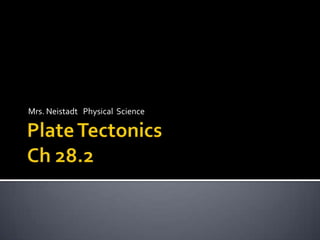
Plate Tectonics Theory Explained
- 1. Mrs. Neistadt Physical Science
- 2. The theory of plate tectonics explains the movement of continents and other geological events like earthquakes and volcanoes. The term tectonics means construction or building. *The theory of plate tectonics, stated in 1965, refers to the movement of giant pieces of solid rock on Earth’s surface called tectonic plates.
- 3. In 1915, Alfred Wegener (1880-1930), a German meteorologist, wrote a book titled The Origin of Continents and Oceans. *Alfred Wegener gathered evidence that supported his idea that all the continents had been connected. *This was the Theory of Continental Drift. 1915
- 5. In the early 1960s, Henry Hess (1906-69), a geologist and former commander of a Navy ship equipped with an echo sounder, used the profile of the sea floor to propose that it was spreading at the mid- ocean ridges. An echo sounder is used to make a profile of the sea floor.
- 6. *Harry Hess *An American geologist who studied mid-ocean ridges. *He suggested that the ocean floors move like conveyor belts, carrying the continents along with them.
- 8. The theory of plate tectonics explains the movement of continents and other geological events like earthquakes and volcanoes. The term tectonics means construction or building. *The theory of plate tectonics, stated in 1965, refers to the movement of giant pieces of solid rock on Earth’s surface called tectonic plates.
- 9. Around the same time, Robert Dietz (1914-95), a scientist with similar ideas, coined the term sea-floor spreading. *Sea-floor spreading describes the sea floor on either side of a mid-ocean ridge as moving away from the ridge and creating a rise or valley.
- 10. *Hot fluid from the mantle (called magma) enters the rise or valley and cools, creating new sea floor (also called oceanic crust).
- 12. In the 1950s and 1960s, scientists discovered that the rocks of the sea floor have a very interesting magnetic pattern. *Over geologic time, the magnetic polarity of Earth has switched. *Scientists believe the poles switch because of a magnetic interaction between the planet’s inner and outer core.
- 13. Stripes of rock with a north-south orientation (normal) alternate with stripes of rock with a south-north orientation (reversed). The blue and white stripes you see in the figure are an interpretation of a magnetic profile.
- 15. The Earth is like a bar magnet, It has a North and South pole. Sketch Bar magnet. Iron filings line up with magnetic field. Concept
- 16. The Geographic North and Magnetic North are not in the same place. The asterisk marks Magnetic North or True North.
- 17. *The Earth’s magnetic poles switch direction. The south pole becomes the north pole, and the north pole becomes the south pole *This switch in direction is known as Magnetic Reversal. Such reversals are caused by changes in Earth’s magnetic field. *Earth’s Geographic Pole never changes place.
- 18. *Each Magnetic Reversal is recorded in the sea-floor rock. As the molten material rises and cools, iron particles line up with Earth’s magnetic field. When the material hardens, these particles stay in place like compass needles that are stuck in position forever.
- 19. *The records of magnetic reversals line up like stripes in a rock Evidence of plate movement is found by finding the age of the rock. The youngest rock shows the last magnetic reversal occurred about 760,000 years ago. The oldest reversal we have found happened 150 million years ago.
- 21. Can you identify which of the plates are only made of oceanic crust?
- 22. Use usgs.gov to find earthquakes in real-time to map the tectonic plates.
- 23. There are three main kinds of plate boundaries: divergent convergent transform
- 24. The tectonic plates that cover Earth’s surface are pieces of the lithosphere that fit together and float on the asthenosphere (a part of the mantle). There are a number of large tectonic plates on Earth’s surface, and smaller plates are being identified all the time.
- 25. Diverging plates move apart and new crust forms.
- 26. Divergent boundaries are sites of earthquakes and volcanic activity. Mid-ocean ridges and associated sea-floor spreading occur at divergent plate boundaries. In effect, a mid-ocean ridge is like a very long volcano.
- 27. Convergent plate boundaries occur where two plates approach each other. One result of two plates converging is subduction. A deep oceanic trench marks the boundary between a subducting and an overriding plate at a convergent boundary.
- 30. The movement of tectonic plates is related to the distribution of heat by convection currents in the mantle.
- 31. Key Question: What will Earth look like in 50 millions years? *Read text section 28.2 BEFORE Investigation 28.2
